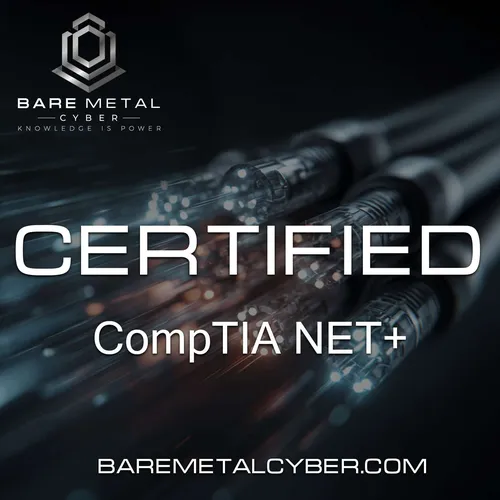
Certified - CompTIA Network + Audio Course
The Network Plus Audio Course is your comprehensive audio training series for mastering the CompTIA Network Plus certification. Designed for learners on the go, this prepcast transforms exam objectives into clear, structured, and engaging episodes tailored for auditory learning. Whether you're walking, commuting, or studying between shifts, each episode breaks down complex networking topics into digestible segments aligned with the official CompTIA blueprint. From OSI layers and IP addressing to wireless standards and troubleshooting methodologies, the series leaves no objective unexplored.
Created by Bare Metal Cyber, a trusted name in cybersecurity education, this prepcast doesn’t just teach — it prepares you for the exam format itself. You’ll learn how to approach multiple-choice questions, understand tricky phrasing, and think like a test writer. Every episode is fully narrated for machine voice clarity, making it perfect for repetition and review. Whether you're a first-time test taker or recertifying, the Network Plus PrepCast helps you build the confidence and competence to pass the exam and succeed in your networking career.
- Update frequency
- every day
- Average duration
- 14 minutes
- Episodes
- 184
- Years Active
- 2025

Episode 105: VLANs — Segmenting the Network with Data and Voice
This episode introduces Virtual Local Area Networks (VLANs), which logically segment networks into separate broadcast domains on the same physical infrastructure. VLANs improve security, performance,…

Episode 104: Bandwidth Management — Shaping and Prioritizing Traffic
This episode explores bandwidth management techniques, including traffic shaping and prioritization. Shaping controls the flow of traffic to match available bandwidth, while prioritization ensures cr…

Episode 102: Link-State and Hybrid Routing Protocols — OSPF, EIGRP, and BGP
This episode examines link-state and hybrid routing protocols, including Open Shortest Path First (OSPF), Enhanced Interior Gateway Routing Protocol (EIGRP), and Border Gateway Protocol (BGP). Link-s…

Episode 101: Dynamic Routing Protocols — Distance Vector and RIP
This episode introduces dynamic routing protocols, focusing on distance vector protocols such as Routing Information Protocol (RIP). Distance vector protocols determine the best path based on hop cou…

Episode 100: Static Routing and Administrative Distance
This episode focuses on static routing, where administrators manually configure routes, and the concept of administrative distance, which determines the trustworthiness of routes when multiple option…

Episode 99: Introduction to Routing — What It Does and Why It Matters
This episode introduces routing, the process of directing packets between networks based on destination IP addresses. Routers use routing tables to determine the best path, ensuring data reaches the …

Episode 98: IoT and SCADA Systems — Small Devices, Big Impacts
This episode examines Internet of Things (IoT) and Supervisory Control and Data Acquisition (SCADA) systems. IoT devices include sensors, cameras, and smart appliances that connect to networks, often…

Episode 97: Networked Devices — VoIP Phones, Printers, and Controls
This episode explores networked devices beyond standard workstations and servers. VoIP phones, network printers, and control systems are introduced as endpoints that rely on network connectivity for …

Episode 96: Firewalls — Stateful Inspection and Access Control
This episode introduces firewalls, which enforce security policies by controlling traffic entering or leaving a network. It explains the difference between packet-filtering, stateful inspection, and …

Episode 95: IPS and IDS Devices — Detecting and Stopping Attacks
This episode explains Intrusion Detection Systems (IDS) and Intrusion Prevention Systems (IPS), which monitor network traffic for signs of malicious activity. IDS devices detect and alert administrat…

Episode 94: Voice Gateways and VoIP Translation
This episode introduces voice gateways, devices that translate between traditional telephony systems and modern Voice over IP (VoIP). They convert circuit-switched voice into packet-switched traffic,…

Episode 93: Modems, Media Converters, and Repeaters
This episode covers modems, media converters, and repeaters, three devices that operate primarily at the physical layer. Modems modulate and demodulate signals for transmission over telephone or cabl…

Episode 92: Proxies and VPN Gateways — Secure Remote Access
This episode explains the role of proxies and VPN gateways in securing and managing remote access. Proxies act as intermediaries between clients and external servers, often providing content filterin…

Episode 91: Load Balancers — Sharing the Traffic Load
This episode introduces load balancers, devices or software that distribute network or application traffic across multiple servers. By balancing requests, they prevent single systems from becoming ov…

Episode 90: Access Points and Wireless LAN Controllers
This episode explains the role of wireless access points (APs) and wireless LAN controllers (WLCs). Access points provide wireless connectivity to client devices, bridging them into wired networks. W…

Episode 89: Hubs and Bridges — Legacy Devices Explained
This episode introduces hubs and bridges, legacy devices that laid the foundation for modern switching. Hubs operate at Layer 1, repeating signals to all ports without intelligence, which creates col…

Episode 88: Routers — Path Decision Makers
This episode focuses on routers, devices that operate at the Network Layer and make path decisions based on logical addressing. Routers examine destination IP addresses, consult routing tables, and f…

Episode 87: Layer 3 Switches — When a Switch Becomes a Router
This episode explains Layer 3 switches, which combine the high-speed switching of Layer 2 with the routing capabilities of Layer 3. These devices can forward packets based on IP addresses, supporting…

Episode 86: Layer 2 Switches — MAC Tables and Forwarding Decisions
This episode introduces Layer 2 switches, which operate at the Data Link Layer and make forwarding decisions based on MAC addresses. Switches maintain a MAC address table, mapping physical addresses …

Episode 85: Welcome to Domain 2 — Network Implementations
This episode introduces Domain 2 of the Network Plus exam, which covers network implementations. While Domain 1 focused on fundamentals, Domain 2 builds on that knowledge by examining how devices, ar…